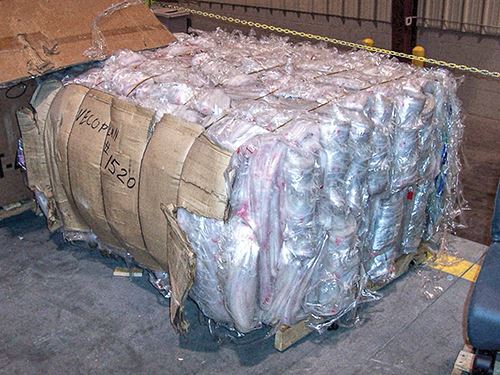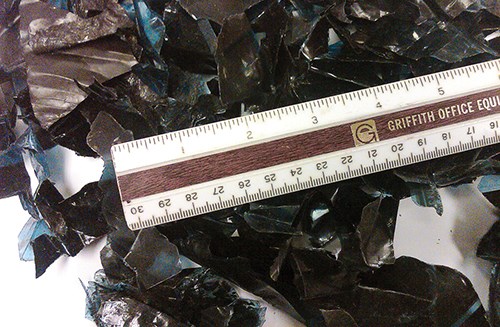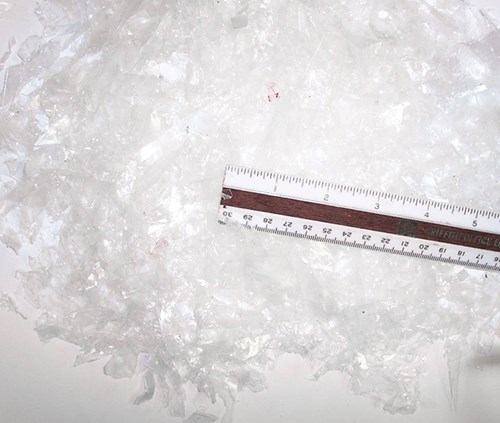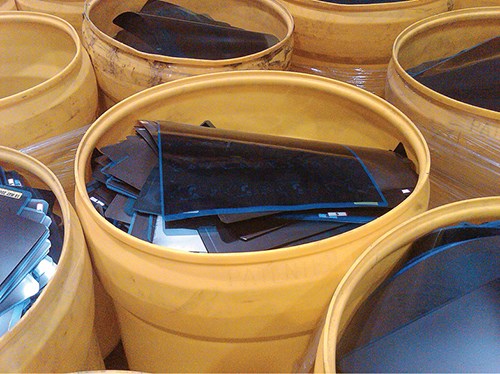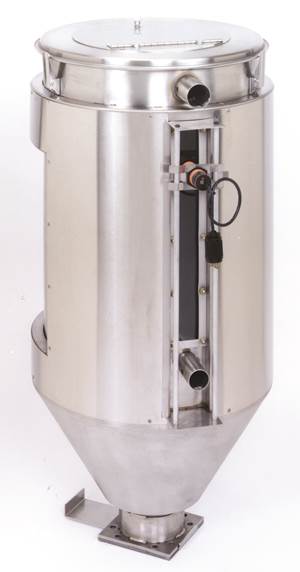Shredding Thin Film: How to Do It Right
While many processors recoil at this task, a little know-how in shredding equipment, processing, and maintenance should add the necessary confidence.
In the world of size reduction, one of the most feared materials to shred is film. Add the word “thin” to “film,” and it is enough to make many processors run for the hills. In reality, there is no need to fear thin film in a shredding operation. With the proper equipment, processes, and maintenance, any type of film can be shredded efficiently and effectively.
“Film” is a very general term, and not all films can be treated equally. Shredding film ranges in difficulty from one extreme of woven PP (so-called super sacks) down to the surprisingly easy other extreme of stretch wrap. The key factor that determines how difficult film is to shred is to what extent the material will self-feed in the shredder, which causes it to wrap around the rotor and to jam the machine. That’s what makes woven films one of the most difficult structures to shred. These films are designed to be very strong by nature and the individual strands are notorious for wrapping around a rotor. Each strand is independent of the others, so cutting one leaves many others uncut to wrap around the rotor.
In cases of self-feeding films, a specially designed film rotor is required. These rotors ensure that every strand or tail is cut prior to fully wrapping 360° around the rotor. One such rotor forces each strand or film tail into the valley of its corrugated rotor, where a nip cutter ensures it does not wrap more than 180°. By cutting each tail that attempts to wrap the rotor, you minimize the self-feeding of the film, so it will run efficiently and without issue.
The other extreme is stretch wrap. Contrary to what most believe, this is one of the easiest films to process, as it tends to ball up and react more like a rigid plastic purging than a film. Since the material sticks to itself so tightly, it does not unravel in the shredder to pose a wrapping risk, but simply shreds into chunks. In this case a standard rotor is all that is required.
It becomes more difficult to determine the proper machine configuration with all of the many film materials that lie between these two extremes. In the end, the primary consideration in determining the type of rotor required is the extent to which the material will stretch, rather than break, during the shredding process. If it does not stretch much before breaking, it should shred fine. On the other hand, if it is very difficult to break because it tends to stretch, you will want to consider a specialized rotor designed for this purpose.
IMPROVING EFFICIENCY
Thin film falls into the middle range of materials where close inspection and possible testing are required to determine the best machine configuration. But assuming you already have a shredder and are not looking to buy a new one, there are ways to improve your efficiency when running thin films.
The first step is to simply identify if and how much the particular film you would like to run is going to be a problem. If you cannot rip or break the film—either due to stretching or to the strength of the material (woven PP)—this may be your first indication that you’ll need a specialized rotor that can handle film and fiber.
The second test would be putting some film in the shredder to see how it reacts. If the material breaks easily in the hand test, you are likely to be OK to feed the shredder normally. If the material has a lot of stretch to it, feed the material slowly. This gives the shredder time to shred the material and reduces self-feeding so too much film is not pulled in, which increases the chance of wrapping and jamming. Slowly increase the feed rate and monitor the rotor closely until you see it starting to struggle with the amount of wrapping. You will want to keep the feed rate comfortably below this level to ensure you do not jam the machine during regular production.
To complete your material analysis, you’ll need a good understanding of the size of pieces that you’ll be shredding. For instance, if you are shredding post-consumer grocery bags, jamming the machine will not be an issue. The size of the film is too small to wrap completely around the rotor and cause a jam. At the other extreme, large sheets of film are much more likely to wrap the rotor multiple times, which is ultimately the cause of a rotor jam.
Now that you know what you are working with and what rate to feed the machine, you can start looking at other aspects to improve your shredding efficiency with thin film.
Of primary importance is the cutting action and tolerances of the cutters. Sharp cutters with a tight tolerance to the opposing knife ensure that the material is actually cut rather than ripped apart. The tight tolerance also ensures that material cannot be pulled through without being cut, reducing the chances of rotor wrapping. During normal operation, it is very important to monitor the tolerances and adjust the counter knives to ensure they are kept as tight as possible.
The second aspect of tolerances that is commonly overlooked is the tolerance of the cutters to the screen. Although the screen in a shredder is not used in the cutting action, the space between the cutters and the screen allows for material to build
up and wrap around the rotor. A shredder with a zero-tolerance screen is essential in this situation. When new, the cutters and screen will touch very slightly. After a few minutes, a slight groove will be made in the screen to allow the cutters to pass freely.
By having zero tolerance with the screen, material is not able to build up between the rotor and the screen, which goes a long way toward preventing wrapping and jamming of the rotor.
Jamming a shredder is one important concern with running thin film; but possibly more important is controlling the temperature of the material so you don’t have a meltdown. For those of you who haven’t experienced a large meltdown, the cleanup is difficult and time consuming, to say the least. Thin film is particularly difficult, as by its nature it melts easily at elevated temperatures. Ideally, your machine will be equipped with a water-cooled rotor, which keeps frictional heat to a minimum and eliminates any worry about a meltdown.
Without a water-cooled rotor, you’ll have to pay very close attention to machine maintenance and operation. Sharp cutters and close tolerances, discussed above. become essential in this situation. The larger the gaps and the more the ripping action, the faster and higher frictional heat will accumulate. Sharp cutters and a close tolerance to the counter knife provide a good cutting action, which minimizes stretching and rubbing and therefore heat. The same concept also applies to the screen tolerance. If material is allowed to build up behind the screen, it blinds the holes so material is not able to exit the shredder, causing continuous frictional heat buildup.
As you can see, there is wariness in the industry about shredding thin films and it is for good reason. The most common answer to thin-film shredding questions is: “It depends.” Although the ability to “dump and run” with a specially designed shredder that can handle anything you throw at it is ideal, this is often not the reality. By carefully analyzing the material you need to process, and by keeping tight controls on the feeding and maintenance of the system, it is possible to achieve shredding success with most thin film.
Related Content
Plastics Technology Year in Review: Your Favorite Reads of 2024
A year-end review of the top stories showcasing industry trends, advancements and expert insights. Revisit the articles that captured the attention of the plastics community.
Read MoreBozzelli’s Guide To Specifying a Dryer
Here's a list of 17 things to do when looking for new drying equipment.
Read MoreThe Importance of Barrel Heat and Melt Temperature
Barrel temperature may impact melting in the case of very small extruders running very slowly. Otherwise, melting is mainly the result of shear heating of the polymer.
Read MoreKnow Your Options in Injection Machine Nozzles
Improvements in nozzle design in recent years overcome some of the limitations of previous filter, mixing, and shut-off nozzles.
Read MoreRead Next
For PLASTICS' CEO Seaholm, NPE to Shine Light on Sustainability Successes
With advocacy, communication and sustainability as three main pillars, Seaholm leads a trade association to NPE that ‘is more active today than we have ever been.’
Read MoreMaking the Circular Economy a Reality
Driven by brand owner demands and new worldwide legislation, the entire supply chain is working toward the shift to circularity, with some evidence the circular economy has already begun.
Read MorePeople 4.0 – How to Get Buy-In from Your Staff for Industry 4.0 Systems
Implementing a production monitoring system as the foundation of a ‘smart factory’ is about integrating people with new technology as much as it is about integrating machines and computers. Here are tips from a company that has gone through the process.
Read More
